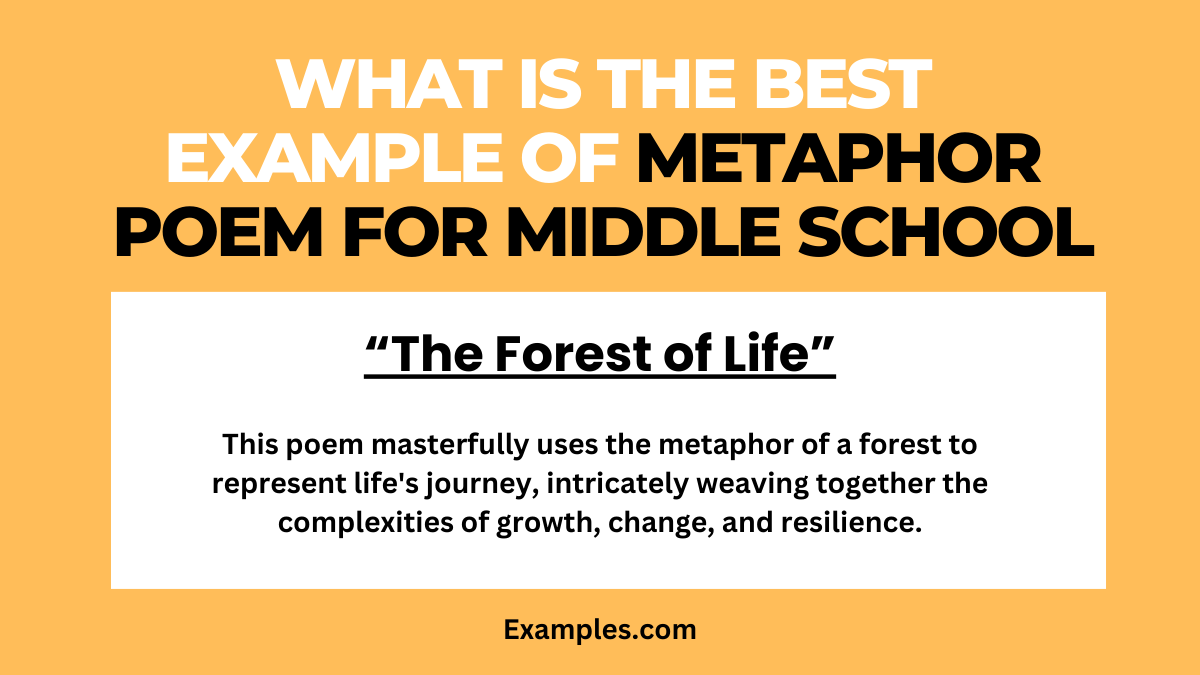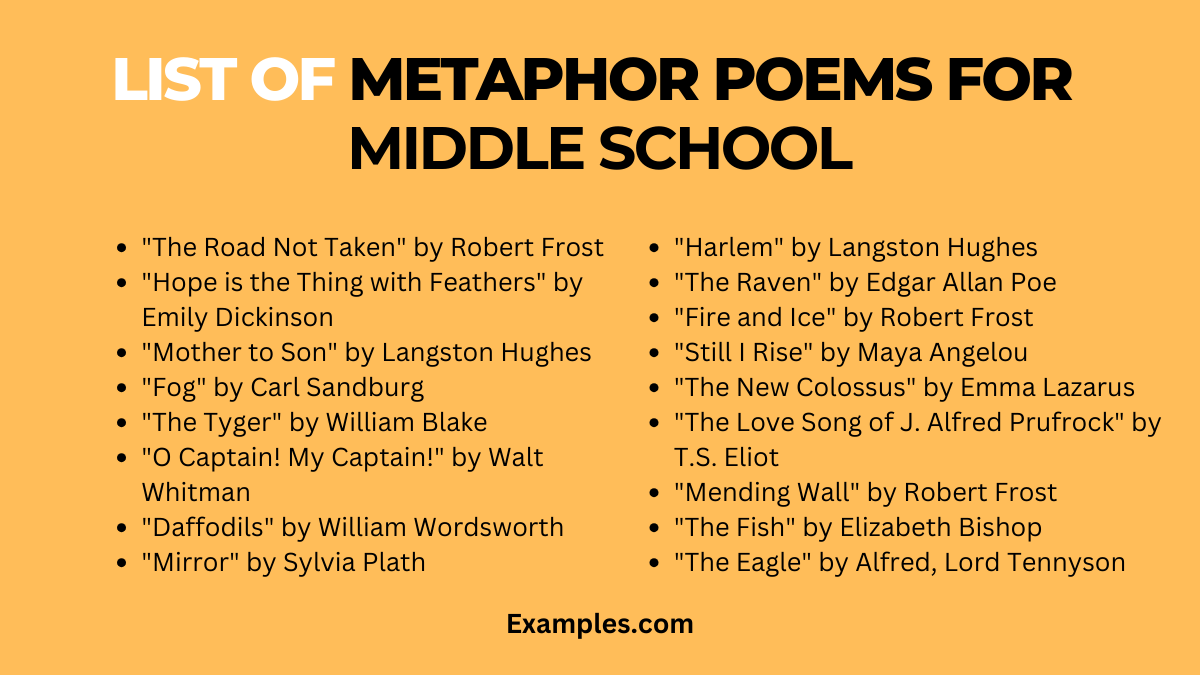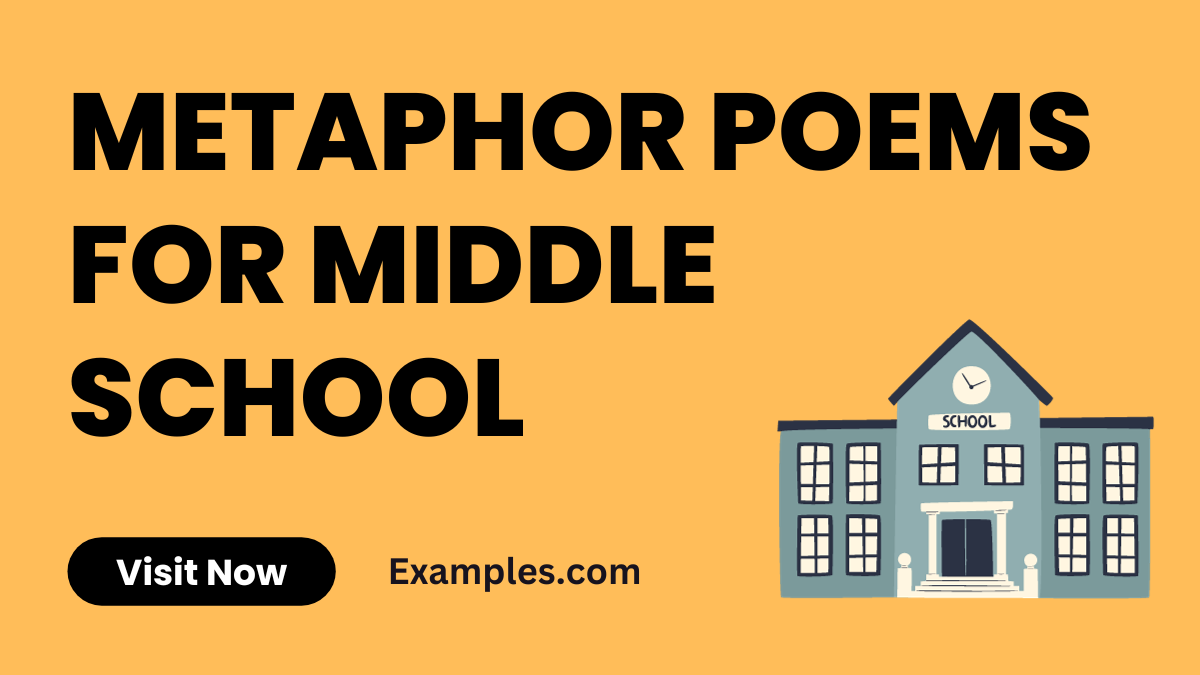14+ Metaphor Poems for Middle School Examples
Delve into the captivating world of metaphor poems, an essential component of middle school literature. This guide offers a treasure trove of metaphor examples, designed to engage young minds and enhance their understanding of this poetic device. Metaphor poems not only enrich language skills but also encourage students to explore and express complex ideas creatively. By illustrating abstract concepts through relatable imagery, these poems become powerful tools for cognitive and emotional development. Discover a variety of metaphor examples and tips to effectively integrate them into middle school curricula, fostering a love for poetry and language.
Download Metaphor Poems for Middle School PDF
What is the Best Example of Metaphor Poems for Middle School?

One of the best examples of a metaphor poem for middle school is “The Forest of Life.” This poem masterfully uses the metaphor of a forest to represent life’s journey, intricately weaving together the complexities of growth, change, and resilience. Each tree symbolizes a different experience, path, or decision, painting a vivid picture of life’s diverse tapestry. This poem not only captures the essence of metaphorical expression but also resonates deeply with middle school students, making it a superb educational and inspirational tool.
List of Metaphor Poems for Middle School

1. The Ocean of Emotions
“The Ocean of Emotions” is a metaphor poem that likens human emotions to the vast, ever-changing ocean. Originating from the natural ebb and flow of the sea, this poem is used in middle school to teach about emotional depth and complexity. It helps students understand and articulate their feelings through the powerful imagery of the ocean. This poem is a staple in curriculums for Metaphor Poems for 4th grade and Metaphor Poems for 5th grade.
Download Full Poem The Ocean of Emotions PDF
Metaphors:
- “Waves of joy” – Throughout the poem: Represents moments of happiness rising and falling like ocean waves.
- “Storms of sorrow” – In several stanzas: Symbolizes intense sadness, akin to a turbulent sea storm.
- “Tides of change” – Repeated motif: Illustrates how emotions can shift and evolve over time, like the ocean’s tides.
2. The Garden of Dreams
“The Garden of Dreams” uses a lush, vibrant garden as a metaphor for the aspirations and dreams of youth. Its origin lies in the parallel between nurturing a garden and cultivating dreams. This poem is often utilized in middle school curriculums to inspire students to nurture their ambitions and hopes. For those exploring Metaphor Poems for 6th grade and Metaphor Poems for Grade 7, “The Garden of Dreams” stands out.
Download Full Poem The Garden of Dreams PDF
Metaphors:
- “Flowers of ambition” – Early in the poem: Represents the budding aspirations of young minds.
- “Thorns of challenge” – Mid-poem: Symbolizes the obstacles and difficulties encountered while pursuing dreams.
- “Fruits of success” – In the conclusion: Depicts the achievements and rewards of hard work and dedication.
3. The Mountain of Challenges
This poem compares life’s challenges to a towering mountain. Originating from the physical and mental effort required to climb a mountain, it’s often used in middle school to teach about perseverance and overcoming obstacles. In Metaphor Poems for Year 8 and for older primary school students, the poem about life’s challenges and a towering mountain is particularly relevant. This poem, often used in Metaphor Poems for Primary School, teaches perseverance and overcoming obstacles, reflecting the physical and mental effort required to climb a mountain.
Download Full Poem The Moutain of Challenges PDF
Metaphors:
- “Steep slopes of struggle” – Throughout the poem: Represents difficult periods in life that require extra effort to overcome.
- “Summit of success” – Near the end: Symbolizes the achievement of overcoming life’s challenges.
- “Paths of perseverance” – Frequently mentioned: Illustrates the various ways one can face and conquer challenges.
4. The River of Knowledge
“The River of Knowledge”a popular choice for Metaphor Poems About Love of learning, likens the pursuit of education to a river’s journey.Its origin is in the natural flow of rivers, symbolizing the continuous and sometimes meandering path of education. This poem is popular in middle schools to illustrate the lifelong journey of learning it an excellent metaphor example in literature and a key component in teaching Metaphor Sentence.
Download Full Poem The River of Knowledge PDF
Metaphors:
- “Currents of curiosity” – Early in the poem: Depicts the driving force of desire to learn and discover.
- “Banks of wisdom” – Throughout the poem: Represents the foundational knowledge that guides the learning journey.
- “Streams of thought” – Scattered across the poem: Symbolizes the diverse ideas and perspectives that feed into our understanding.
5. The Forest of Friendship
This poem uses the metaphor of a forest to explore the dynamics of friendship. It originated from the diversity and interconnectedness of a forest ecosystem, often used in middle school to teach about cooperation, diversity, and the strength found in friendships.
Download Full Poem The Forest of Friendship PDF
Metaphors:
- “Trees of trust” – Mentioned early on: Represents the strong, deep-rooted bonds of friendship.
- “Leaves of laughter” – In several stanzas: Symbolizes the joy and happiness shared among friends.
- “Branches of bonding” – Throughout the poem: Illustrates how friendships grow and branch out in different directions.
6. The Symphony of Life
“The Symphony of Life” portrays life as a grand musical symphony, with each phase representing a different movement. Originating from the harmony and complexity of a symphony, it’s used in middle schools to teach about the different stages of life and their interconnectedness.
Metaphors:
- “Melodies of youth” – In the first movement: Represents the vibrant and energetic phase of early life.
- “Harmonies of maturity” – In the middle movements: Symbolizes the balanced and stable period of adulthood.
- “Crescendos of change” – Throughout the poem: Illustrates the pivotal moments that bring significant changes in life.
7. The Canvas of Imagination
This poem compares the limitless scope of imagination to a blank canvas. Its origin lies in the creative freedom of painting, making it a popular choice in middle school curriculums to encourage creativity and individual expression.
Metaphors:
- “Brushstrokes of ideas” – Frequently mentioned: Represents the unique thoughts and ideas that each person brings to the canvas of life.
- “Palette of possibilities” – Early in the poem: Symbolizes the diverse options and opportunities available to us.
- “Colors of creativity” – Scattered across the poem: Depicts the vibrancy and variety of creative expression.
8. The Lighthouse of Learning
“The Lighthouse of Learning” metaphorically compares education to a guiding lighthouse. Its origin lies in the idea of education being a guiding light in life, often used in middle schools to emphasize the importance of knowledge and guidance. These poems draw from imagery of guiding lighthouses and seafaring adventures, making them suitable for lessons on Metaphor for Kids and Easy Metaphor.
Metaphors:
- “Beams of understanding” – Throughout the poem: Represents the enlightening effect of education.
- “Rocks of ignorance” – Mentioned occasionally: Symbolizes the obstacles that education helps to navigate.
- “Waves of wisdom” – In the latter part: Illustrates the continuous spread and influence of knowledge.
9. The Clock of Seasons
This poem personifies the four seasons as different hours on a clock, teaching about the cyclical nature of time and seasons. It’s a useful educational tool in middle schools for understanding change and continuity.
Metaphors:
- “Hands of time” – Repeatedly mentioned: Represents the relentless passage of time.
- “Spring’s awakening hour” – Describing spring: Symbolizes renewal and new beginnings.
- “Winter’s resting minute” – Referring to winter: Depicts a time of rest and reflection.
10. The Ship of Dreams
“The Ship of Dreams” uses the metaphor of a ship to represent the journey of aspirations and goals. Drawing from seafaring imagery, it’s popular in middle schools for encouraging students to set sail towards their dreams with determination.
Metaphors:
- “Sails of ambition” – Throughout the poem: Represents the driving force behind one’s dreams and goals.
- “Winds of opportunity” – Mentioned frequently: Symbolizes the external factors that can help or hinder the journey towards achieving dreams.
- “Anchor of reality” – In the middle stanzas: Illustrates the grounding effect of practicality and realism in pursuing aspirations.
Famous Metaphor Poems for Middle School
1. “The Road Not Taken” by Robert Frost
One of the most celebrated poems by Robert Frost, “The Road Not Taken,” uses the metaphor of a road to symbolize life choices. Its origin lies in Frost’s personal experiences, and it is widely used in middle school curriculums to teach about decision-making and the impact of choices on life.
Metaphors:
- “Two roads diverged in a yellow wood” – Beginning of the poem: Represents life’s divergent paths and choices.
- “Sorry I could not travel both” – First stanza: Symbolizes the impossibility of experiencing all life choices.
- “I took the one less traveled by” – Last stanza: Depicts the uniqueness and courage in making less conventional life choices.
2. “Hope is the Thing with Feathers” by Emily Dickinson
Emily Dickinson’s “Hope is the Thing with Feathers” metaphorically compares hope to a bird. The poem’s serve as Metaphor in Literature and are excellent resources for teaching Metaphor in Romeo and Juliet and Example of a Metaphor in a Song.
Metaphors:
- “Hope is the thing with feathers” – First line: Represents hope as a bird, delicate yet resilient.
- “That perches in the soul” – First stanza: Symbolizes hope residing within the human spirit.
- “And never stops at all” – First stanza: Illustrates the enduring and omnipresent nature of hope.
3. “Mother to Son” by Langston Hughes
Langston Hughes’ “Mother to Son” uses the metaphor of a staircase to represent life’s journey. The poem’s origin is in Hughes’ exploration of resilience and perseverance, often used in middle school to teach about overcoming life’s challenges and hardships. For advanced students, exploring Hard Metaphor and Metaphor in Semantics can be enriched by including Metaphors in Business Talk and Metaphors for Personality Traits.
Metaphors:
- “Life for me ain’t been no crystal stair” – Throughout the poem: Represents the difficulties and challenges of life.
- “Tacks in it, and splinters” – Within the poem: Symbolizes the various obstacles and painful experiences one encounters.
- “Don’t you fall now” – Near the end: Urges perseverance and strength in the face of life’s struggles.
Short Metaphor Poems for Middle School
1. “Stars of Wisdom”
“Stars of Wisdom” is a short metaphor poem that compares knowledge to stars in the night sky. Its origin is in the idea of knowledge being illuminating and vast, and it is used in middle school to inspire a love for learning and curiosity. The versatility of metaphors in various contexts, from Metaphors for Love and Metaphors for Life to Metaphor for Business and Metaphor of Brands.
Metaphors:
- “Stars of wisdom” – Throughout the poem: Represents bits of knowledge shining in the vast sky of ignorance.
- “Galaxy of understanding” – Middle of the poem: Symbolizes the comprehensive and interconnected nature of learned concepts.
- “Comets of insight” – Scattered in the poem: Depicts sudden realizations or bright ideas.
2. “Waves of Change”
“Waves of Change” is a brief poem that uses ocean waves as a metaphor for the changes in life. Originating from the natural phenomenon of changing tides, this poem is used in middle schools to teach about adaptability and the constant nature of change.
Metaphors:
- “Waves of change” – Repeated motif: Represents the continuous and inevitable changes in life.
- “Tides of time” – Throughout the poem: Symbolizes the passage of time and its role in bringing change.
- “Currents of choice” – In the latter part: Illustrates how our decisions can direct the course of our lives.
3. “Butterfly of Growth”
“Butterfly of Growth” is a succinct, metaphorical poem that compares personal growth to the life cycle of a butterfly. Originating from the natural transformation of caterpillars, it’s used in middle schools to teach about change and development.
Metaphors:
- “Cocoon of comfort” – Early in the poem: Represents the initial safety and limitations of one’s comfort zone.
- “Wings of wisdom” – Mid-poem: Symbolizes the growth and learning that lead to maturity.
- “Flight of freedom” – Conclusion: Depicts the liberation and potential that comes with personal growth.
Best Metaphor Poems for Middle School
1. “The City of Dreams”
“The City of Dreams” is a metaphor poem that likens aspirations to a bustling city. Its origin is in the vibrancy and diversity of urban life, used in middle school to inspire students to dream big and appreciate the multitude of opportunities life offers.
Metaphors:
- “Skyscrapers of ambition” – Throughout the poem: Represents towering goals and aspirations.
- “Streets of possibilities” – Frequently mentioned: Symbolizes the various paths and opportunities available to achieve one’s dreams.
- “Lights of success” – In the closing lines: Depicts the achievements and victories along the journey.
2. “The Tree of Knowledge”
“The Tree of Knowledge” is a metaphorical poem that compares the pursuit of wisdom to a growing tree. Originating from the concept of knowledge as a living, growing entity, it’s used in middle schools to encourage continual learning and intellectual growth.
Metaphors:
- “Roots of understanding” – Early in the poem: Represents the foundational knowledge that supports further learning.
- “Branches of thought” – Throughout the poem: Symbolizes the expanding and branching nature of ideas and concepts.
- “Leaves of lessons” – Scattered in the poem: Depicts the individual learnings and insights gained through education.
3. “The Bridge of Friendship”
“The Bridge of Friendship” uses the metaphor of a bridge to explore the connections and bonds of friendship. Its origin lies in the idea of friendships bridging differences and distances, commonly used in middle school to teach about relationships and cooperation.
Metaphors:
- “Pillars of trust” – Throughout the poem: Represents the strong foundation upon which friendships are built.
- “Arch of understanding” – Mid-poem: Symbolizes the mutual comprehension and empathy in friendships.
- “Path of companionship” – In the final lines: Depicts the journey of friendship as a shared path through life.
Funny Metaphor Poems for Middle School
1. The Laughing Llama
“The Laughing Llama” is a humorous poem that uses the metaphor of a llama to represent laughter and joy in life. Originating from the quirky and amusing behavior of llamas, this poem is a hit in middle schools, used to teach about the lighter side of life and the importance of humor. For younger students, especially in Metaphor Poems for 3rd grade, poems like “The Laughing Llama” and “The Dancing Donut” are ideal.
Metaphors:
- “Giggles of grass” – When describing the llama eating: Represents the infectious nature of laughter.
- “Hills of hilarity” – Throughout the poem: Symbolizes the ups and downs of life experienced with a positive attitude.
- “Stream of smiles” – Mentioned in the last stanza: Depicts the continuous flow of happiness and joy.
2. The Dancing Donut
This whimsical poem, “The Dancing Donut,” humorously likens a donut to the circle of life, filled with sweetness and surprises. It’s popular in middle schools for its playful take on life’s journey, using a donut as a metaphor for the unexpected and delightful aspects of everyday life. They are perfect for teaching Simile and Metaphor in a fun and engaging manner.
Metaphors:
- “Twirls of sugar” – In the opening lines: Represents the sweet, pleasant moments in life.
- “Glaze of glee” – Mid-poem: Symbolizes the shiny, happy experiences that coat our days.
- “Sprinkles of spontaneity” – Near the end: Illustrates the random, joyful surprises that life offers.
3. The Sneezing Sunflower
“The Sneezing Sunflower” is a funny and engaging poem that uses the metaphor of a sunflower to explore the humorous aspects of nature. It’s a favorite among middle school students for its lighthearted portrayal of a sunflower reacting to different elements in its environment.
Metaphors:
- “Breezes of tickles” – Throughout the poem: Represents the light, amusing experiences that life brings.
- “Pollen of giggles” – In several scenes: Symbolizes the contagious nature of laughter, much like pollen in the air.
- “Leaves of laughter” – Mentioned often: Depicts the continuous joy and humor found in everyday life.
Metaphor poems are a delightful and educational journey for middle school students, offering a unique blend of creativity, language skills, and emotional learning. This complete guide, with its diverse examples, serves as an essential resource for educators and students like metaphor unit Poem. It not only enriches the classroom experience but also fosters a deeper appreciation for the beauty and power of metaphorical language. These poems, ranging from thoughtful to funny, are ideal for engaging young minds and sparking a lifelong interest in poetry and literature.


